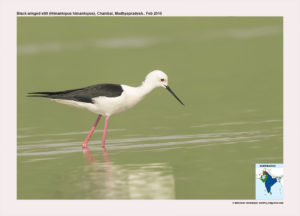Black-winged Stilt

Black-winged Stilt Himantopus himantopus
Etymology:
- Himantopus : Latin word for Wading Bird
- Himantopus : Latin word for Wading Bird
Vernacular Names : Sind: Gusling, Hindi: Gazpaon, TinghurChaha, Sans: Kalpakshprawalpad, Pun: Lamlatta, Bi: Sargain, Sargyne, Ben: Lalgon, Lalthengr, Langora, Guj: Gaj-paon, Mar: Shekatya, Ta: Pavallakaalullan, Paduva kali, Mal: Pavizhakkali, Sinh: Kalapu-kirala
Distribution in India: Resident of North West India and wide spread visitor in India.
Description: Size of 35–40 cm; wt. of 166–205g, wingspan 67–83 cm. It has very long pink legs; thin black bill; wingsand back areblack, often with greenish gloss. The underside is white and the tail is white with variable grey banding. The female has upperparts duller brown, lacking greenish gloss. Non-breeding adults of nominate race develop more extensive grey on crown, nape and hindneck. JuvenileJuvenile restingare similar to adult female. Races differ mainly in coloring and pattern of head and hindneck.
Habitat:It is found in shallow wetlands of tropical and temperate regions. During breeding it is found in freshwater sites, including marshes and swamps, lake edges, riverbeds, sewage ponds and flooded fields, but also saltpans and coastal saltmarshes. It is found from ground level to 4200 m
Food habits : They are carnivorous, preying on great variety of small, mainly aquatic, invertebrates and vertebrates, occasionally seeds. Main prey types are larvae and adults of aquatic insects, especially beetles, mayflies , caddisflies , water-bugs, dragonflies, flies, alderflies , and butterflies and moths,bivalves and gastropods, crustaceans, spiders, worms and tadpoles, small fish and their eggs. Itcaptures prey by a variety of visual and tactile methods including scything in soft mud when prey not visible, e.g. at night. The males often feed in deeper water than females, but they typically prefers shallow water. They rarely forage on dry land or in water up to belly deep, even swims occasionally.
Breeding habits : They breed in Apr–Oct in S Africa, Mar in N Africa ,Feb in Cape Verdes and Arabia, later with increasing latitude, and not until May in N parts of range; altitude also affects timing, e.g. in New, July-Aug in New Zealand, Apr-Aug in USA and May to Aug in Brazil. It is seasonally monogamous. It does a butterfly-like display flight used to advertise territory. The nests are widely spaced on groundamongst grasses and sedges, containing seashell fragments, plant materials and salt grains. Sometimes nest is floating mass of water weeds. They lay a clutch of 3–6 eggs. The incubation period is 22–29 days. The incubation is done by both sexes, but mainly female, starting with final egg. The fledging period is 28–32 days.